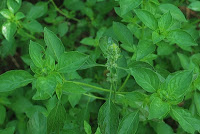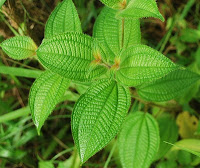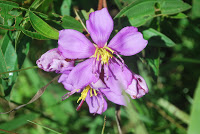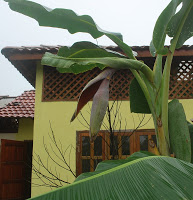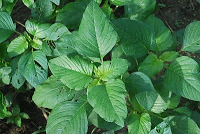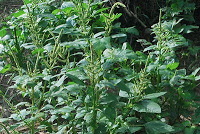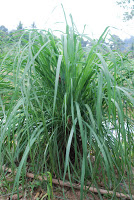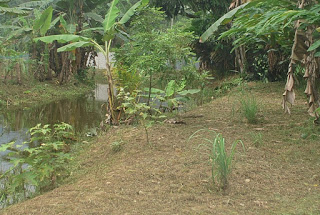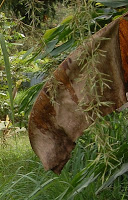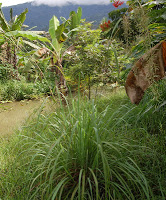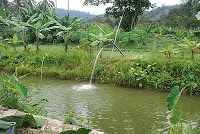 |
| Inflorescence on a 1m high Banana Plant |
Living in a tropical country, in my opinion, Malaysia has ideal conditions for growing bananas (known as pisang in Malay) and the varieties are endless. The banana plants also provide a nice, cool shade and is a great water absorber, especially with all the rain that we get here. At the farm, there are over 400 plants and I especially like to have some around the perimeter of the house as it keeps the house cool.
 |
| Pisang Lemak Manis |
I am still learning to differentiate the various types of plants before the fruits come out but still have a long way to go. Among the types planted are Pisang Raja, Embun, Udang, Lemak Manis, Rastali, Berangan, Berangan Kampung, Awak, Abu, Abu Bunga, Telor, Kapas, Nangka and Emas. I am still trying to locate Pisang Tanduk starter plant. I am sure that there are other varieties in Malaysia and I am constantly on the lookout for those that I do not have. My interest is only in local banana plants so Cavendish and those like it are not on my interest list neither are GMO varieties. For my taste, “original” types are best in taste and flavour especially when you let them “ripen” on the plant itself. As with my other trees and plants, natural-source fertlizers are what I use and chemical pesticides are a no-no.
There are two types of Pisang Awak, one with seeds and one without. My personal preference is for those without seeds and I love banana fritters (pisang goreng) for this type of banana and it definitely cuts the enjoyment of this dish when you bite into a seed. So, only seedless varieties are planted on the farm. After all, if it is not good enough for me, then it is not good enough for my customers.
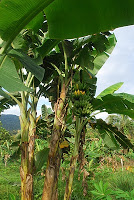 |
| Pisang Awak Ripening nicely |
The banana plant is really one of the plants whereby the whole plant serves one purpose or another. Of course the fruit – bananas – have a high nutrition value. The inflorescense (jantung) also known as the banana heart, can be eaten raw (as an ulam) or cooked in savoury dishes. The leaves serves as a highly organic, recyclable food wrapper and this is where I can do my bit in preserving the environment – I use it to wrap my produce when I take it to market. The pseudostem (batang pisang) can be cooked in curries, chopped and fed to my fishes, and as a soil improver by adding more organic content to my soil. The base root serves as a propagation mechanism. All in all, a remarkable plant.
Bananas as a food source can be eaten in so many ways:
- uncooked, it can be a “dessert”, a great breakfast item on its own or added to cereal, or blended into a banana milk shake and of course, an important component in Banana Split sundae.
- in sweet dishes such as pancakes, desserts, breads and cakes
- in savoury dishes such as curries
- smoked and eaten as a snack
- sliced and dried and made into banana chips
Not all inflorescence (jantung pisang) taste good, in fact some are bitter. I find that the tastiest ones are from Pisang Abu and we sell only these at the market.
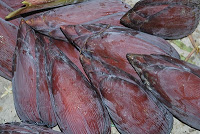 |
| Jantung Pisang Abu |
Bananas are one of the popular produce at my Sunday morning market stall with Pisang Raja leading the pack. I am never sure what variety I will have for sale from week to week as it really depends on which is ripe. I find that letting the bananas ripen on the plant really produces a tasty banana and since I sell what I produce, I can wait till the best time before harvesting and taking to market. This allows me to compete better against the other vendors. Most Sundays, I am sold-out and on those that I am not, I am left with enough for my own consumption. I do not take orders for bananas but sell on a first come first serve basis. My adventure with bananas continues……

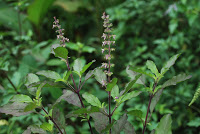 This shrub is also know as Selasih Hitam in Malay (Botanical name : Ocinum Tenuiflorum) and grows to about 1.5 m in height in sunny, good drainage and with regular watering. It makes for a beautiful shrub in your garden and is propagated via seeds.
This shrub is also know as Selasih Hitam in Malay (Botanical name : Ocinum Tenuiflorum) and grows to about 1.5 m in height in sunny, good drainage and with regular watering. It makes for a beautiful shrub in your garden and is propagated via seeds.  The leaves are are green which turn to purplish as it matures and it has tiny clusters of flowers at the end of the stem. When the flowers matures and dries, it produces tiny seeds which is easily blown away by the breeze so on the farm, I let natural propagation to take place. The stem is purple – color – which makes it an interesting plant to have in the landscape. Frequent pruning keeps the shrub nice and healthy as the stems tend to dry out after the flower matures.
The leaves are are green which turn to purplish as it matures and it has tiny clusters of flowers at the end of the stem. When the flowers matures and dries, it produces tiny seeds which is easily blown away by the breeze so on the farm, I let natural propagation to take place. The stem is purple – color – which makes it an interesting plant to have in the landscape. Frequent pruning keeps the shrub nice and healthy as the stems tend to dry out after the flower matures.
